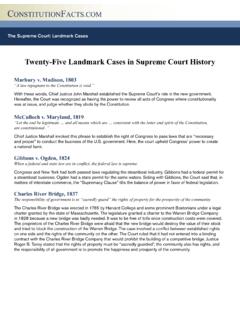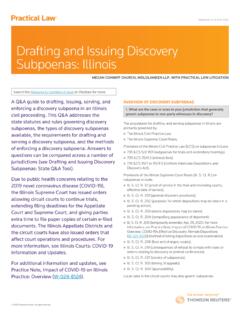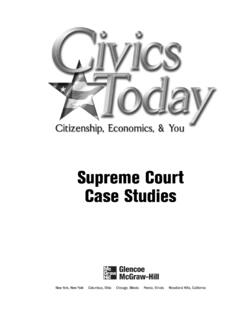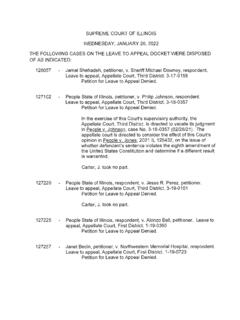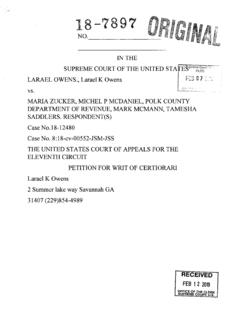Transcription of Supreme Court eFileIL Policy User Manual
1 ELECTRONIC FILING PROCEDURES AND USER Manual FOR THE Supreme Court OF illinois 1. Electronic Filing Required in Civil Cases. Unless exempt, all documents in civil cases on the Court 's General Docket shall be filed with the Court electronically in accordance with the Court 's Order entered on January 22, 2016 in In re: Mandatory Electronic Filing in Civil Cases ( 18368) and any amendments thereto, Supreme Court Rules and as provided in this Supreme Court of illinois Electronic Filing Procedures and User Manual (" Manual "). Documents filed in people cases on the Court 's General Docket and documents filed on the Court 's Miscellaneous Record Docket (MR Docket) may be filed electronically.
2 2. Definitions. The following terms shall be defined as follows: a. "Electronic Filing Service Provider" (EFSP) means an approved vendor for electronic filing in the State of illinois at b. "Electronic Filing Manager" (EFM) means a solution approved by the Court that enables documents to be filed, served, and distributed electronically while integrating with both the EFSPs and the Court 's case management system. c. "Public Access Terminal" means a publicly accessible computer and scanner provided by the Court for the purposes of facilitating electronic filing with the Court . Public access terminals are available during normal business hours in the Supreme Court Clerk's office in Springfield and its satellite office in Chicago. d. "Electronic Filing" (e-filing) means filing a digital document with the Court directly from the registered user's computer or a Public Access Terminal using an approved EFSP.
3 E. "Transaction Confirmation" means a confirmation that is transmitted to a registered user after the user has submitted a transaction through an EFSP to the Court . At a minimum, the transaction confirmation displays an envelope number and the date and time the transaction was submitted by the registered user through the EFSP. The transaction confirmation may serve as the filer's proof of submission. f. "Envelope Number" means a unique number assigned by the EFM to each e-filing transaction and may be used to track an e- filing transaction. g. "PDF" means Portable Document Format, a proprietary file format developed by Adobe Systems, Inc. h. "Registered User" means an individual who has registered a username and password with the EFM. 1 i.
4 "Technical Failure" means a malfunction of the EFM, EFSP, or the Court 's hardware, software, and or telecommunications facility which results in the inability of a registered user to submit a document for e- filing. It does not include the failure of a user's equipment. 3. Secured Documents. a. Confidential, impounded, sealed or otherwise secured documents ("secured") shall be submitted only when clearly designated as such at the time of filing. b. Motions for leave to file a secured document may be e-filed and must be designated as such at the time of submission. The secured document shall be submitted at the same time as the motion, but in a separate transaction than the transaction containing the motion. 4. Registration, Change of Contact Information, Usernames and Passwords. a. Registration to become a user through eFileIL is available on an approved EFSP's website.
5 For a list of approved EFSP vendors, visit b. The registrant shall provide the EFSP the requested registration information, including a secure username and password. This username and password shall also function as a signature on each e-filed document, as provided in paragraph 6, and will authorize payment of all filing fees and service fees, if any, as provided in paragraph 10. c. If an attorney is suspended or disbarred by the Court , his or her e-filing account access will be suspended. d. The Court reserves the right to revoke a registered user's privileges with or without cause. e. Once registered, it is the responsibility of the registered user to keep his or her e-mail address and other contact information current with the Court and the EFSP. 5. Format of e-filed document. a. Except as otherwise provided, an e- filed document shall comply with current Supreme Court Rules, including but not limited to page and word limitations, page size, font type, margin width and font size.
6 B. An e-filed document must be in text-searchable PDF format compatible with the latest version of Adobe Reader. Except as otherwise provided by this Manual , an e-filed document created by a word processing program must not be a scan of the original but must instead be converted directly into a PDF file using Adobe Acrobat, a word processing program's PDF conversion utility, or anot her software program. Whenever possible, scanning should be avoided. 2 c. If scanning is unavoidable, the scanned document must be made searchable using optical-character-recognition software, such as Adobe Acrobat Professional, and have a resolution of 300 dots per inch (dpi) with a "black and white" setting.
7 D. The size of any single transaction shall not exceed 150 megabytes. e. Documents in different cases submitted in a single transaction will be rejected. f. Documents submitted for e-filing shall include a proof of service for the filing and any other item required by Supreme Court Rules as a single file and be placed at the end of the document. g. If a document requires leave of Court before filing, the registered user shall attach the proposed document as an exhibit to the motion for leave in a single transaction. The proposed document shall also be submitted for e-filing, but in a separate transaction than the transaction containing the motion requesting leave. h. Appendix materials may be scanned if necessary, but scanning should be avoided when possible. An appendix shall be combined into one computer file with the document it is associated with for purposes of e-filing, unless the resulting computer file would exceed 150 megabytes.
8 In such case, the registered user is responsible for dividing the document into appropriately sized parts, with each part having a separate cover page that labels each part of the appendix ( Appendix, Part 1; Appendix, Part 2 etc.), and submitting the parts in separate transactions that do not exceed 150 megabytes. i. An e-filed document item may contain hyperlinks to another part of the same document, an external source cited in the document, an appendix item associated with the document, an embedded case, or a record citation. A hyperlink within an appendix item is also permitted. Any external material behind the link is not considered part of the e-filing. j. An e-filed document must not contain a virus or malware. The e-filing of a document constitutes a certification by the registered user that the document has been checked for viruses and malware.
9 K. A document requiring a specific color cover page pursuant to Supreme Court Rule 341 shall be submitted for e-filing in compliance with Rule 341. Upon acceptance and filing, the paper copies submitted to the Clerk's office pursuant to paragraph 8 of this Manual shall also contain the appropriate color cover page and be the printed version of the e-filed document bearing the Clerk's electronic stamp. l. The Court may reject an e-filed document for nonconformance with this Manual or Supreme Court Rules. 3 6. Signatures on e-filed documents. a. Except as otherwise provided, the confidential, secure username and password that the registered user must use to e-file a document constitute the registered user's signature on the document, in compliance with requirements of Supreme Court Rules and statutes regarding original signatures on Court documents.
10 When a signature is provided in this manner, the registered user must also include either an "/s/" and the registered user's name typed in the space where the registered user's signature would otherwise appear or an electronic image of the registered user's signature, which may take the form of a public key-based digital signature or a scanned image of the registered user's signature. b. The registered user shall not allow his or her username or password to be used by anyone other than an agent who is authorized by the registered user. c. If a document is notarized, sworn to or made under oath, the registered user must e-file the document as a scanned image containing an image of the necessary original signature(s). A document certified pursuant to Section 1-109 of the Code of Civil Procedure may contain an electronic signature as described in subparagraph a.

